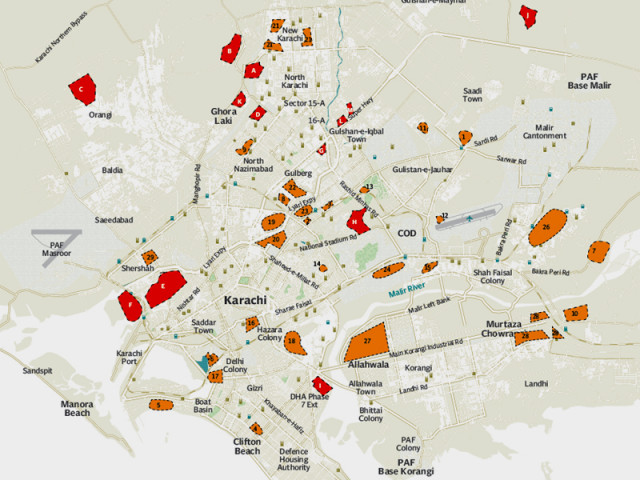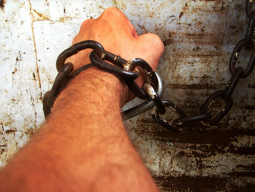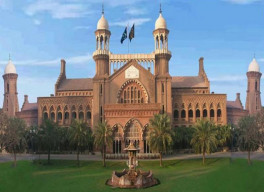
Shortly after the armed forces launched the Kalosha II operation in South Waziristan back in 2004, the crocodiles lazing in the murky natural pond in Manghopir got new neighbours. Suddenly, they weren’t the most dangerous residents of the area.
Embedded in the increased influx of Mehsud tribesmen coming to Karachi were militants who settled in Pakhtun-dominated areas of the city, attempting to blend in unnoticed. They would soon go on to disrupt the life of the city’s residents - including the crocodiles at Hazrat Khawaja Hassan’s shrine, which was closed for over a month following the bomb attack in 2010 on Abdullah Shah Ghazi’s shrine.
“First, the hunters - the law enforcers - used to only get hurt when they dared to put their hands in the den of the lions, the militants. Now it seems as if the lions have come out of the den and are stalking the hunters themselves,” DSP Qamar Ahmed told The Express Tribune.
The militants, including Tehreek-e-Taliban Pakistan (TTP) members, now have an iron grip over parts of the city, including Sohrab Goth, Manghopir and Ittehad Town. Over the years, they made increasingly brazen attacks, including one on Sohrab Goth police station on January 29 this year.

SHO Ashfaq Baloch of the Manghopir police station admits that it is difficult to impose the writ of the state in his jurisdiction and that standard operating procedures followed by law enforcers elsewhere in the city have to be bent - very drastically.
“When a killing occurs somewhere else in the city, a lone constable usually hops onto a motorcycle and speeds off to the scene of the crime. Here, we can’t think of doing that unless we have a death wish,” he said. “We have to make sure our weapons are loaded. Then an entire team, headed by me, gets into a police mobile. Only when we pacify the criminals that we haven’t come to apprehend them can we advance safely to retrieve the body.”
SHO Baloch added that he prefers not to send the officers on duty to pick up a body. “We often wait for a body to turn up at one of the hospitals and then head there to question the family and any eyewitnesses.” What about raids and patrols in the area? SHO Baloch shakes his head.
DSP Ahmed’s statement seems to suggest that no-go areas in the city will grow organically like cancer. Should we fear that criminals want all-out anarchy where the law of the jungle is followed all over the city? SSP Amir Farooqi, who heads the police’s Orangi division, doesn’t think so. “They don’t want to turn Karachi into a war zone.
“They’re here to recruit people and generate funds to send back to their comrades along the tribal belt. Setting the economic hot spot of Pakistan ablaze wouldn’t exactly be conducive for this purpose.”
No-go areas only for a particular ethnicity in times of ethnic violence (Orange)
1. Safoora Goth
2. Area near Micassa apartment
3. Area around Old Sabzi Mandi
4. Shireen Jinnah Colony
5. Shah Rasool Colony
6. Hijrat Colony and Sultanabad
7. Memon Goth
8. Sharifabad
9. Kati Pahari
10. Quaidabad
11. Bilawal Shah Noorani Goth
12. Pehlwan Goth
13. Hazara Goth
14. Sherpao Basti
15. Natha Khan Goth
16. Bizerta Lines
17. Delhi Colony
18. Chanesar Goth
19. Ilyas Goth
20. PIB Colony
21. Parts of New Karachi
22. Azizabad
23. Jamali Goth
24. Areas along Drigh Road
25. Jackson and docks
26. Khokrapar
27. Mehran Town
28. Parts of Landhi
29. Shershah
Complete no-go areas because of the presence of militants or gangsters (Red)
A. Pakhtunabad
B. Sultanabad
C. Ittehad Town
D. New Mianwali Colony
E. Parts of Lyari
F. Macchar Colony
G. Settlements in Sohrab Goth
H. Shanti Nagar & Dalmia
I. Qayyummabad
J. Afghan Basti
K. Kunwari Colony
L. Chota Plaza
M. Supermarket area of Sohrab Goth
Published in The Express Tribune, March 23rd, 2013.

















COMMENTS
Comments are moderated and generally will be posted if they are on-topic and not abusive.
For more information, please see our Comments FAQ